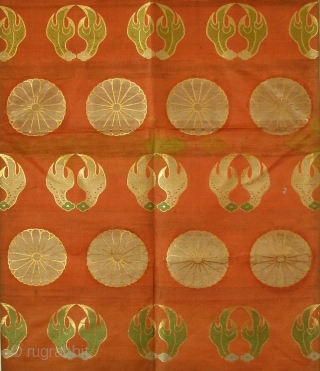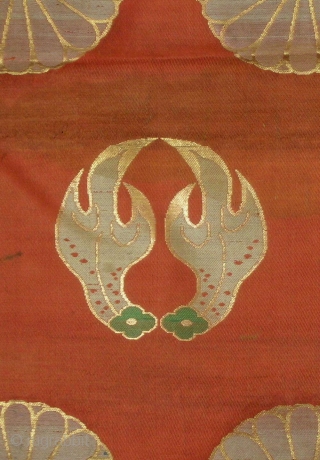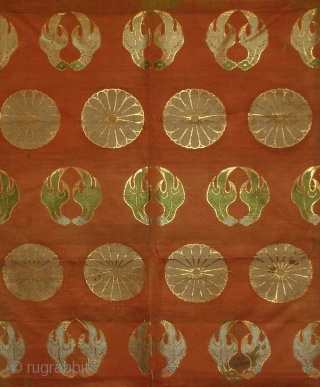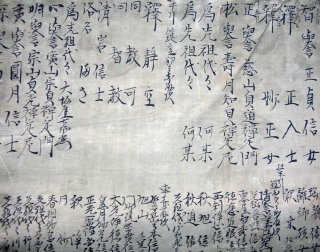Back
Silk temple cloth, Japan, Edo (18th century), cm 215x66. This is an ‘uchishiki’, a cloth of rich silk used to decorate altars in Buddhist temples. The origin of the uchishiki can be traced back to the lifetime of Shakyamuni Buddha. During the Buddha's time a custom was established of spreading out fine pieces of cloth for the Buddha to sit on when preaching to his disciples and others assembled to hear him. The cloth would be spread out and the disciples would bow in reverence to the Buddha with their foreheads touching the cloth at his feet. It later came to decorate the altar tables of temples on special occasions of hearing the Buddha's teaching. The cloth we are offering here is of particularly beauty, depicting alternate rows of flowerheads and confronting leaves in delicate shades of pastel colors, outlined with gold on a rust silk background. The choice of colors, the very essential look and the rather sheer size of motifs, are quite typical of late 17th/early 18th century fabrics woven for the aristocrat class. It is lined with ‘washi’ the traditional Japanese paper and profusely inscribed by the devotee who presented it to the temple. The quality of inscription of the B-side itself should prompt the connoisseur to appreciate this big cloth that, however, gives its best when looked from the front. 250 years of life have left signs: some staining on the silks, tiny holes and wear, particularly on the washi that results fraying in places. All this, however, detracts just bits from the beauty of this object, that literally glows when struck by light. Lascivious, monumental and stunning
price:
SOLD
- Home
- Antique Rugs by Region
- Category
- Profiles
- Post Items Free
- Albums
- Benaki Museum of Islamic Art
- Budapest: Ottoman Carpets
- Gulbenkian Museum
- Islamic Carpets. Brooklyn
- Islamic Textiles. Brooklyn
- Konya Museum: Rugs
- MKG, Hamburg
- MMA: Caucasian Carpets
- MMA: Mamluk Carpets
- MMA: Mughal Indian Carpets
- MMA: Ottoman Carpets
- MMA: Safavid Persian Carpets
- MMA: Turkmen Rugs
- McCoy Jones Kilims
- Ottoman textiles. Met
- Philadelphia Museum
- Rugs and Carpets: Berlin
- Seljuqs at the Met
- TIEM, Istanbul: Carpets
- V&A: Classical Carpets
- Vakiflar Carpets: Istanbul
- Baluch Rugs: Indianapolis
- Gallery Exhibitions
- Jaf an Exhibition
- Alberto Levi Gallery
- Andean Textile
- Christie's London: 2016
- Francesca Galloway
- HALI at 40
- ICOC Washington, DC 2018
- Jajims of the Shahsavan
- London Islamic Week April, 2018
- Mongolian Felts
- Navajo Rugs: JB Moore
- Persian Piled Weavings
- SF Tribal & Textile Art Show 2020
- SF Tribal 2019
- Sotheby's: C. Alexander
- Turkish Prayer Rugs
- Turkmen Main Carpets ICOC 2007














